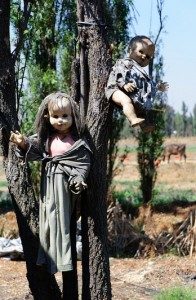
As if you needed yet another reason to be weary of leaving the sanctuary that is your home, from the annals of the paranormal comes a new freaky cryptid, or being, or whatever.
This time, the creature is so strangely silly it’s actually quite frightening, I’m referring to black stick-men. No, they are not an adaptation of the blue man group, and though they seem to be popping up everywhere, it’s unlikely they’ll be invited to perform in Las Vegas.
The first written accounting of the black stick-men appears on Listverse.com, wherein the site founder, Jamie Frater lists some of the weirdest examples of paranormal phenomenon. Black stick-men appear at number three on his list, beating out such entities as dog-head men and El Chupacabras. Frater describes them as totally black, thin, stick figures, as you might see in a

kindergarten class. They are, apparently, two-dimensional beings, “impossibly tall” and walking with a strange sort of loping gait.
Frater says that they show surprise when they are discovered and will actually pursue witnesses, though no harm has ever been reported as a result of a stick-man encounter. It seems that there is a parallel between the stick-men and Shadow People (schattenwesen) and even the black-eyed kidphenomenon. Frater even says that some reports claim the stick-men wear “top hats”, much like Shadow People.
Frater’s list was published on Listverse.com on April 24, 2009, and if you take the time to read through the comments (which are quite long) you’ll find several first and second hand accounts of stick-man encounters, such as this one from user Simon Howes:
“In 1982, when I was a student nurse at Warley Hospital, Brentwood in Essex, England, I encountered a ‘stick person’ in the grounds of the Hospital as I was walking home one night. It lopped across the roadway having been, seemingly, pressed up against a wall. It stopped when it saw me and raised it’s arms in fright and quickly walked off into the undergrowth. It was very tall with very thin, extremely long arms and legs and a very small oval head. Totally black and no obvious clothing. I saw no face even though it emerged very near a street lamp and so was well illuminated. I was terrified and to this day, no-one believes me…”
As you can see, the phenomenon or at least witness accounts of it have been in circulation for some 30 years, making the black stick-men not so much new as rediscovered.
Apparently, a stick-man encounter leaves the witness with a pointed feeling of dread and danger, much like the feelings reported by Shadow People witnesses. Some have speculated, in the case of Shadow People, that they are inter-dimensional beings, rather than something ghostly, demonic or extraterrestrial. Could the black stick-men be visitors from another dimension as well?

I’ve written about inter-dimensionality before, wherein I pointed out that a dimension is nothing more than a direction – i.e. up, down, back and forth. We live in a three dimensional world right? (Height, width and depth) Well actually no, we live in a world of many dimensions – many physicists believe there are 10 space dimensions and one time dimension, some think there are more – but we can only experience three of those dimensions (four if you include time). The others are tightly wrapped up into minute sub-atomic (actually sub-sub-atomic) geometric shapes that we are incapable of detecting, except through the mathematics of quantum physics.
The idea that a being could be from such a place is nonsense, mainly because other dimensions aren’t places at all. But maybe I’m being too literal, when one says that a being is from another dimension, they could be referring to, say, another universe, if you subscribe to the many-worlds hypothesis, or the multiverse theory. Others yet may be referring to something more ephemeral or perhaps a realm such as heaven or hell, but where those places may actually be is a mystery.
In any event, where they come from is only one part of the experience, and a small part at that. The black stick-men, a phenomenon that appears to be increasing in frequency, if you believe Tony Harrington of The Spirit Seekers, a phenomenon that is set to become the next paranormal fad. What they are, wispy and thin, is up for debate, and unfortunately the only evidence we have of their existence thus far is anecdotal testimony of apparently random people on internet forums and blogs.
What do you think, are the black stick-men a hoax or an urban legend, or are they a real entity? Are they connected in some way to the Shadow People or the black-eyed kids? Express your opinion in the comment section below. And as always, keep your eyes open!
Edit: While not black, the “stick-men” in the following YouTube video may just be an example of the above. Thanks to Syd for bringing them to my attention.
















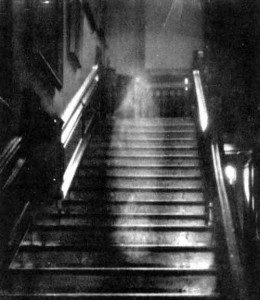 Fortunately for our civilization at the time, electrical appliances weren’t in widespread use, and as a result, only a few telegraph services experienced a temporary disruption. A similar geomagnetic storm today would decimate our technologically dependent culture, rendering all computers, cell phones (and telephones for that matter) and vehicles useless, at least temporarily if not permanently.
Fortunately for our civilization at the time, electrical appliances weren’t in widespread use, and as a result, only a few telegraph services experienced a temporary disruption. A similar geomagnetic storm today would decimate our technologically dependent culture, rendering all computers, cell phones (and telephones for that matter) and vehicles useless, at least temporarily if not permanently.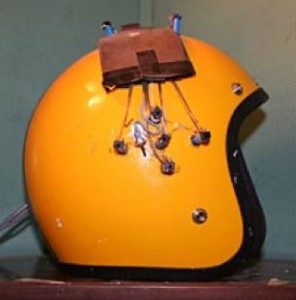







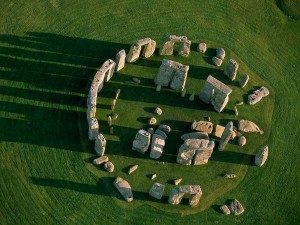 Among the megalithic structures of the ancient world, from huge pyramid complexes that boggle the mind, to rock walls consisting of precisely carved and placed stones of almost unimaginable size, to mysterious and beautiful stone circles, our history is rich with examples of ancient artistry and ingenuity.
Among the megalithic structures of the ancient world, from huge pyramid complexes that boggle the mind, to rock walls consisting of precisely carved and placed stones of almost unimaginable size, to mysterious and beautiful stone circles, our history is rich with examples of ancient artistry and ingenuity. Rollrite Stones – Actually three distinct Bronze Age Neolithic monuments, the Rollrite Stones consist of The King’s Men, The King Stone and The Whispering Knights. The three sites are located near the village of Long Compton on the border of Oxfordshire and Warwickshire in the English Midlands. The Whispering Knights, a dolmen (a single chamber megalithic tomb), was the first to be built in approximately the 2nd millennium BCE, with The King’s Men following somewhere between the 2nd and 4th millennium BCE. The King’s Men is a stone circle believed to have trade based origins, much like Castlerigg, acting as a meeting place or market. The King Stone, located just north of The King’s Men, is a single standing stone of unknown date. It is believed to have been a marker for or a component of a Long Barrow or other burial site, but there is some speculation as to its alignment to the stone circle. The Rollritte Stones, especially The King’s Men, are an important site for neo-pagan magico-religious rituals.
Rollrite Stones – Actually three distinct Bronze Age Neolithic monuments, the Rollrite Stones consist of The King’s Men, The King Stone and The Whispering Knights. The three sites are located near the village of Long Compton on the border of Oxfordshire and Warwickshire in the English Midlands. The Whispering Knights, a dolmen (a single chamber megalithic tomb), was the first to be built in approximately the 2nd millennium BCE, with The King’s Men following somewhere between the 2nd and 4th millennium BCE. The King’s Men is a stone circle believed to have trade based origins, much like Castlerigg, acting as a meeting place or market. The King Stone, located just north of The King’s Men, is a single standing stone of unknown date. It is believed to have been a marker for or a component of a Long Barrow or other burial site, but there is some speculation as to its alignment to the stone circle. The Rollritte Stones, especially The King’s Men, are an important site for neo-pagan magico-religious rituals.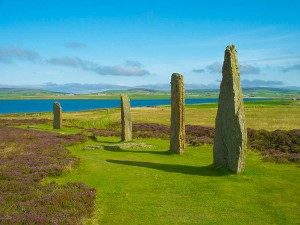 The Ring of Brodgar – (Also Brogar or Ring o’ Brodgar) The third largest stone circle in the British Isles and the youngest monument on the Ness o’ Brodgar, The Ring of Brodgar is believed to have been built between 2500 BCE and 2000 BCE. It has typically defied traditional dating techniques, and as the centre of the circle has never been excavated, little is known about its true age and purpose. The Ring sits in the West Mainland parish of Stenness, on Orkney Isle in Scotland. Among several other Neolithic sites in Orkney, The Ring of Brodgar enjoys protection as a World Heritage Site under the Heart of Neolithic Orkney. The site’s caretakers from Historic Scotland describe the site as “…the finest known truly circular late Neolithic or early Bronze Age stone ring and a later expression of the spirit which gave rise to Maeshowe.”
The Ring of Brodgar – (Also Brogar or Ring o’ Brodgar) The third largest stone circle in the British Isles and the youngest monument on the Ness o’ Brodgar, The Ring of Brodgar is believed to have been built between 2500 BCE and 2000 BCE. It has typically defied traditional dating techniques, and as the centre of the circle has never been excavated, little is known about its true age and purpose. The Ring sits in the West Mainland parish of Stenness, on Orkney Isle in Scotland. Among several other Neolithic sites in Orkney, The Ring of Brodgar enjoys protection as a World Heritage Site under the Heart of Neolithic Orkney. The site’s caretakers from Historic Scotland describe the site as “…the finest known truly circular late Neolithic or early Bronze Age stone ring and a later expression of the spirit which gave rise to Maeshowe.”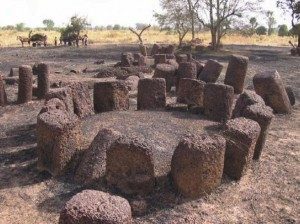 The Senegambian Stone Circles– Actually a collection of four large groups of stone circles, the Senegambian Stone Circles consist of over 1000 individual circles spread out over an area of approximately 15,000 square miles in and around Gambia, Senegal. Unlike some stone circle monuments in Western Europe, the Senegambian Stone circles, which were built around the eighth century, almost unanimously mark ritualistic burial sites. The circles were built by the ancestors of the Serer people of Senegal and have some connection to the steles of Roog, the supreme deity of the Serer religion. Also appearing on the World Heritage List, UNESCO describes the collection as “…a vast sacred landscape created over more than 1,500 years. It reflects a prosperous, highly organized and lasting society.”
The Senegambian Stone Circles– Actually a collection of four large groups of stone circles, the Senegambian Stone Circles consist of over 1000 individual circles spread out over an area of approximately 15,000 square miles in and around Gambia, Senegal. Unlike some stone circle monuments in Western Europe, the Senegambian Stone circles, which were built around the eighth century, almost unanimously mark ritualistic burial sites. The circles were built by the ancestors of the Serer people of Senegal and have some connection to the steles of Roog, the supreme deity of the Serer religion. Also appearing on the World Heritage List, UNESCO describes the collection as “…a vast sacred landscape created over more than 1,500 years. It reflects a prosperous, highly organized and lasting society.”



